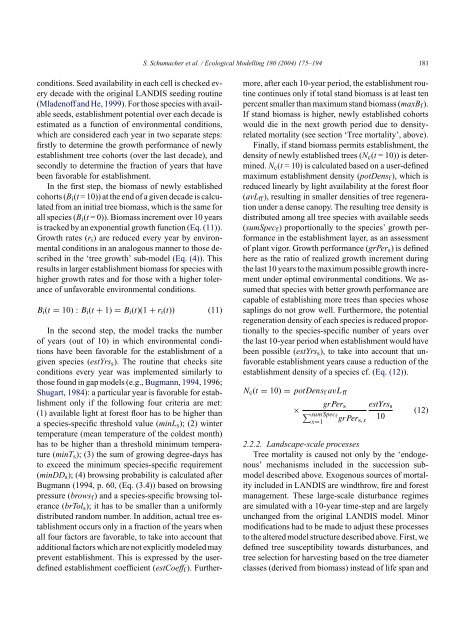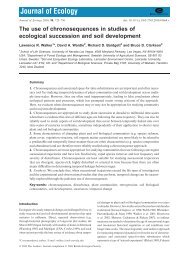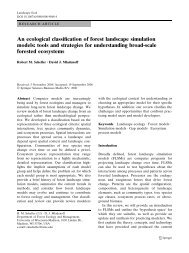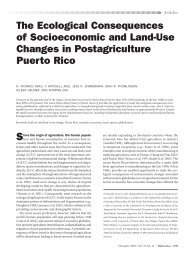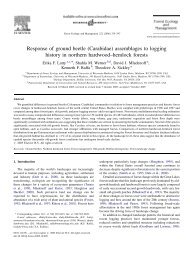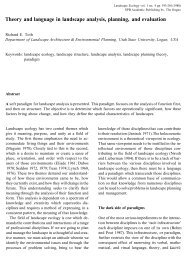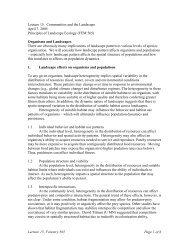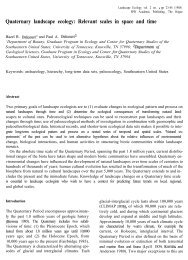Improving the formulation of tree growth and succession in a ...
Improving the formulation of tree growth and succession in a ...
Improving the formulation of tree growth and succession in a ...
You also want an ePaper? Increase the reach of your titles
YUMPU automatically turns print PDFs into web optimized ePapers that Google loves.
S. Schumacher et al. / Ecological Modell<strong>in</strong>g 180 (2004) 175–194 181<br />
conditions. Seed availability <strong>in</strong> each cell is checked every<br />
decade with <strong>the</strong> orig<strong>in</strong>al LANDIS seed<strong>in</strong>g rout<strong>in</strong>e<br />
(Mladen<strong>of</strong>f <strong>and</strong> He, 1999). For those species with available<br />
seeds, establishment potential over each decade is<br />
estimated as a function <strong>of</strong> environmental conditions,<br />
which are considered each year <strong>in</strong> two separate steps:<br />
firstly to determ<strong>in</strong>e <strong>the</strong> <strong>growth</strong> performance <strong>of</strong> newly<br />
establishment <strong>tree</strong> cohorts (over <strong>the</strong> last decade), <strong>and</strong><br />
secondly to determ<strong>in</strong>e <strong>the</strong> fraction <strong>of</strong> years that have<br />
been favorable for establishment.<br />
In <strong>the</strong> first step, <strong>the</strong> biomass <strong>of</strong> newly established<br />
cohorts (B i (t = 10)) at <strong>the</strong> end <strong>of</strong> a given decade is calculated<br />
from an <strong>in</strong>itial <strong>tree</strong> biomass, which is <strong>the</strong> same for<br />
all species (B i (t = 0)). Biomass <strong>in</strong>crement over 10 years<br />
is tracked by an exponential <strong>growth</strong> function (Eq. (11)).<br />
Growth rates (r i ) are reduced every year by environmental<br />
conditions <strong>in</strong> an analogous manner to those described<br />
<strong>in</strong> <strong>the</strong> ‘<strong>tree</strong> <strong>growth</strong>’ sub-model (Eq. (4)). This<br />
results <strong>in</strong> larger establishment biomass for species with<br />
higher <strong>growth</strong> rates <strong>and</strong> for those with a higher tolerance<br />
<strong>of</strong> unfavorable environmental conditions.<br />
B i (t = 10) : B i (t + 1) = B i (t)(1 + r i (t)) (11)<br />
In <strong>the</strong> second step, <strong>the</strong> model tracks <strong>the</strong> number<br />
<strong>of</strong> years (out <strong>of</strong> 10) <strong>in</strong> which environmental conditions<br />
have been favorable for <strong>the</strong> establishment <strong>of</strong> a<br />
given species (estYrs s ). The rout<strong>in</strong>e that checks site<br />
conditions every year was implemented similarly to<br />
those found <strong>in</strong> gap models (e.g., Bugmann, 1994, 1996;<br />
Shugart, 1984): a particular year is favorable for establishment<br />
only if <strong>the</strong> follow<strong>in</strong>g four criteria are met:<br />
(1) available light at forest floor has to be higher than<br />
a species-specific threshold value (m<strong>in</strong>L s ); (2) w<strong>in</strong>ter<br />
temperature (mean temperature <strong>of</strong> <strong>the</strong> coldest month)<br />
has to be higher than a threshold m<strong>in</strong>imum temperature<br />
(m<strong>in</strong>T s ); (3) <strong>the</strong> sum <strong>of</strong> grow<strong>in</strong>g degree-days has<br />
to exceed <strong>the</strong> m<strong>in</strong>imum species-specific requirement<br />
(m<strong>in</strong>DD s ); (4) brows<strong>in</strong>g probability is calculated after<br />
Bugmann (1994, p. 60, (Eq. (3.4)) based on brows<strong>in</strong>g<br />
pressure (brows f ) <strong>and</strong> a species-specific brows<strong>in</strong>g tolerance<br />
(brTol s ); it has to be smaller than a uniformly<br />
distributed r<strong>and</strong>om number. In addition, actual <strong>tree</strong> establishment<br />
occurs only <strong>in</strong> a fraction <strong>of</strong> <strong>the</strong> years when<br />
all four factors are favorable, to take <strong>in</strong>to account that<br />
additional factors which are not explicitly modeled may<br />
prevent establishment. This is expressed by <strong>the</strong> userdef<strong>in</strong>ed<br />
establishment coefficient (estCoeff f ). Fur<strong>the</strong>rmore,<br />
after each 10-year period, <strong>the</strong> establishment rout<strong>in</strong>e<br />
cont<strong>in</strong>ues only if total st<strong>and</strong> biomass is at least ten<br />
percent smaller than maximum st<strong>and</strong> biomass (maxB f ).<br />
If st<strong>and</strong> biomass is higher, newly established cohorts<br />
would die <strong>in</strong> <strong>the</strong> next <strong>growth</strong> period due to densityrelated<br />
mortality (see section ‘Tree mortality’, above).<br />
F<strong>in</strong>ally, if st<strong>and</strong> biomass permits establishment, <strong>the</strong><br />
density <strong>of</strong> newly established <strong>tree</strong>s (N c (t = 10)) is determ<strong>in</strong>ed.<br />
N c (t = 10) is calculated based on a user-def<strong>in</strong>ed<br />
maximum establishment density (potDens f ), which is<br />
reduced l<strong>in</strong>early by light availability at <strong>the</strong> forest floor<br />
(avL ff ), result<strong>in</strong>g <strong>in</strong> smaller densities <strong>of</strong> <strong>tree</strong> regeneration<br />
under a dense canopy. The result<strong>in</strong>g <strong>tree</strong> density is<br />
distributed among all <strong>tree</strong> species with available seeds<br />
(sumSpec f ) proportionally to <strong>the</strong> species’ <strong>growth</strong> performance<br />
<strong>in</strong> <strong>the</strong> establishment layer, as an assessment<br />
<strong>of</strong> plant vigor. Growth performance (grPer s ) is def<strong>in</strong>ed<br />
here as <strong>the</strong> ratio <strong>of</strong> realized <strong>growth</strong> <strong>in</strong>crement dur<strong>in</strong>g<br />
<strong>the</strong> last 10 years to <strong>the</strong> maximum possible <strong>growth</strong> <strong>in</strong>crement<br />
under optimal environmental conditions. We assumed<br />
that species with better <strong>growth</strong> performance are<br />
capable <strong>of</strong> establish<strong>in</strong>g more <strong>tree</strong>s than species whose<br />
sapl<strong>in</strong>gs do not grow well. Fur<strong>the</strong>rmore, <strong>the</strong> potential<br />
regeneration density <strong>of</strong> each species is reduced proportionally<br />
to <strong>the</strong> species-specific number <strong>of</strong> years over<br />
<strong>the</strong> last 10-year period when establishment would have<br />
been possible (estYrs s ), to take <strong>in</strong>to account that unfavorable<br />
establishment years cause a reduction <strong>of</strong> <strong>the</strong><br />
establishment density <strong>of</strong> a species cf. (Eq. (12)).<br />
N c (t = 10) = potDens f avL ff<br />
×<br />
grPer s estYrs s<br />
∑ sumSpecf<br />
x=1<br />
grPer s,x<br />
10<br />
(12)<br />
2.2.2. L<strong>and</strong>scape-scale processes<br />
Tree mortality is caused not only by <strong>the</strong> ‘endogenous’<br />
mechanisms <strong>in</strong>cluded <strong>in</strong> <strong>the</strong> <strong>succession</strong> submodel<br />
described above. Exogenous sources <strong>of</strong> mortality<br />
<strong>in</strong>cluded <strong>in</strong> LANDIS are w<strong>in</strong>dthrow, fire <strong>and</strong> forest<br />
management. These large-scale disturbance regimes<br />
are simulated with a 10-year time-step <strong>and</strong> are largely<br />
unchanged from <strong>the</strong> orig<strong>in</strong>al LANDIS model. M<strong>in</strong>or<br />
modifications had to be made to adjust <strong>the</strong>se processes<br />
to <strong>the</strong> altered model structure described above. First, we<br />
def<strong>in</strong>ed <strong>tree</strong> susceptibility towards disturbances, <strong>and</strong><br />
<strong>tree</strong> selection for harvest<strong>in</strong>g based on <strong>the</strong> <strong>tree</strong> diameter<br />
classes (derived from biomass) <strong>in</strong>stead <strong>of</strong> life span <strong>and</strong>


